英汉翻译教案 Unit 1 翻译标准
- 格式:ppt
- 大小:667.00 KB
- 文档页数:32
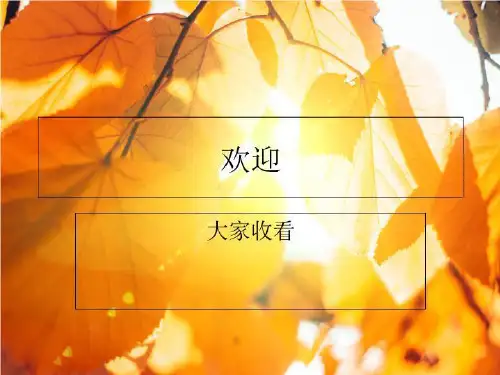
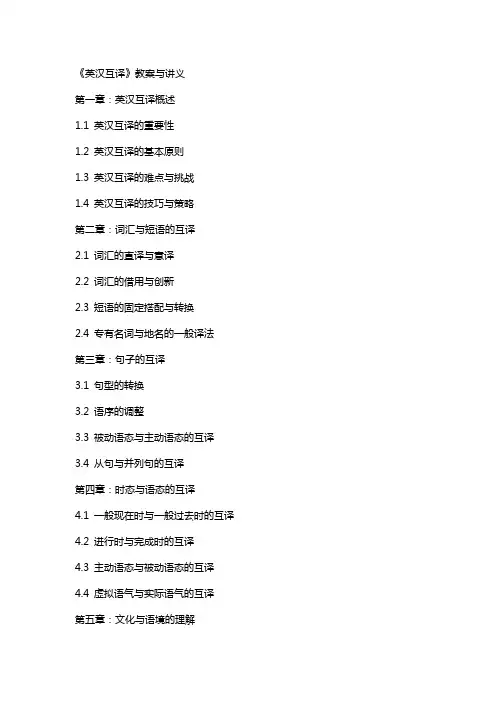
《英汉互译》教案与讲义第一章:英汉互译概述1.1 英汉互译的重要性1.2 英汉互译的基本原则1.3 英汉互译的难点与挑战1.4 英汉互译的技巧与策略第二章:词汇与短语的互译2.1 词汇的直译与意译2.2 词汇的借用与创新2.3 短语的固定搭配与转换2.4 专有名词与地名的一般译法第三章:句子的互译3.1 句型的转换3.2 语序的调整3.3 被动语态与主动语态的互译3.4 从句与并列句的互译第四章:时态与语态的互译4.1 一般现在时与一般过去时的互译4.2 进行时与完成时的互译4.3 主动语态与被动语态的互译4.4 虚拟语气与实际语气的互译第五章:文化与语境的理解5.1 文化背景知识的重要性5.2 语境的理解与运用5.3 语言习惯与表达方式的差异5.4 跨文化交流的技巧与策略第六章:翻译标准与原则6.1 翻译标准的历史演变6.2 忠实原则与达意原则6.3 等效翻译与功能翻译6.4 翻译中的创译与意译第七章:翻译技巧与策略(上)7.1 词义选择与词性转换7.2 修辞格的翻译7.3 成语与谚语的翻译7.4 诗歌与文学作品的语言特点与翻译第八章:翻译技巧与策略(下)8.1 幽默与讽刺的翻译8.2 商务与法律文本的翻译8.3 科技与医学文本的翻译8.4 翻译中的校对与润色第九章:实践案例分析9.1 英汉互译案例分析9.2 翻译错误分析与避免9.3 翻译实践与反馈9.4 翻译作品的评价与赏析第十章:翻译软件与辅助工具10.1 翻译软件的种类与功能10.2 翻译辅助工具的使用10.3 语料库与在线翻译资源10.4 在翻译领域的应用与展望重点和难点解析一、英汉互译概述难点解析:理解英汉两种语言的结构差异,如语序、句型、时态和语态的使用,以及文化背景和语境的理解。
二、词汇与短语的互译难点解析:不同语言中词汇的内涵和外延可能存在差异,需要根据语境进行适当的调整。
三、句子的互译难点解析:不同语言的句子结构差异,如主被动语态的转换,以及保持原意的调整语序。

新标准大学英语1课后翻译Unit 1 Friendship。
Part I。
1. 我有一个好朋友,她叫玛丽。
她是一个非常聪明和有趣的女孩。
I have a good friend, her name is Mary. She is a very smart and interesting girl.2. 我们经常一起上学,一起吃午饭,一起做作业。
We often go to school together, have lunch together, and do homework together.3. 玛丽是一个很好的倾听者,她总是在我需要的时候给我建议。
Mary is a good listener, she always gives me advice when I need it.4. 我们经常分享彼此的快乐和痛苦,这让我们的友谊更加牢固。
We often share our joys and sorrows, which makes our friendship stronger.5. 有时候我们也会有争吵,但是我们总是很快就和好了。
Sometimes we argue, but we always make up quickly.Part II。
1. 我们的友谊是建立在信任和理解的基础上的。
Our friendship is based on trust and understanding.2. 无论发生什么事情,我们都会互相支持和鼓励。
No matter what happens, we always support and encourage each other.3. 我相信这样的友谊会一直持续下去。
I believe that this kind of friendship will last forever.4. 我们经常一起度过美好的时光,这让我们的大学生活变得更加丰富多彩。
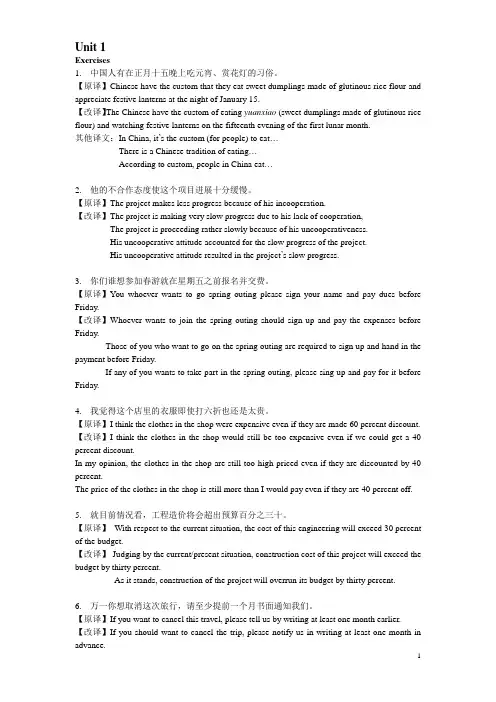
Unit 1Exercises1.中国人有在正月十五晚上吃元宵、赏花灯的习俗。
【原译】Chinese have the custom that they eat sweet dumplings made of glutinous rice flour and appreciate festive lanterns at the night of January 15.【改译】The Chinese have the custom of eating yuanxiao (sweet dumplings made of glutinous rice flour) and watching festive lanterns on the fifteenth evening of the first lunar month.其他译文:In China, it’s the custom (for people) to eat…There is a Chinese tradition of eating…According to custom, people in China eat…2.他的不合作态度使这个项目进展十分缓慢。
【原译】The project makes less progress because of his incooperation.【改译】The project is making very slow progress due to his lack of cooperation,The project is proceeding rather slowly because of his uncooperativeness.His uncooperative attitude accounted for the slow progress of the project.His uncooperative attitude resulted in the project’s slow progress.3.你们谁想参加春游就在星期五之前报名并交费。

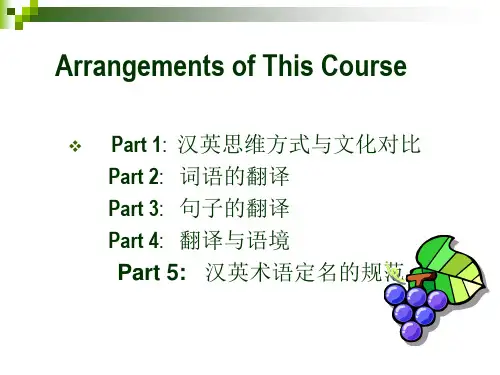
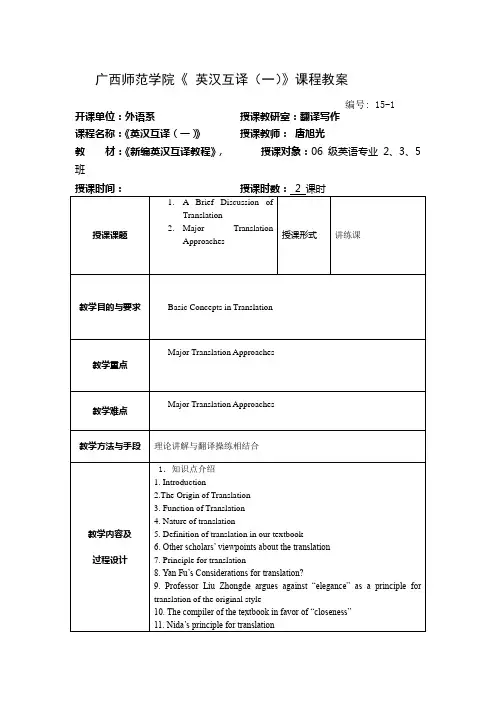
广西师范学院《英汉互译(一)》课程教案编号: 15-1 开课单位:外语系授课教研室:翻译写作课程名称:《英汉互译(一)》授课教师:唐旭光教材:《新编英汉互译教程》,授课对象:06级英语专业2、3、5班《英汉互译(一)》第一讲翻译简论与主要翻译方法(A Brief Discussion of Translation and Major Translation Approaches)1. IntroductionTranslation studies started along with translation practice. Translation theories developed flourishingly in the 20th century, especially in the second half of the last century.In fact, translation, which is a very complex phenomenon, is related to different disciplines, such as linguistics, psychology, sociology, cultural anthropology, communication theory, literary criticism, aesthetics, and semiotics. As translation study is a cross-discipline and cross-culture subject involving many aspects of human knowledge, the lack of a fully acceptable theory of translation should not come as a surprise. Meanwhile, quite a number of translation approaches and strategies have become universally acceptable and widely applicable. They are, of course, the fruits of many translation theorists and translation practitioners at home and abroad.2.The Origin of TranslationLanguage makes it possible for people to communicate with one another freely so as to complete important tasks in human life. Translation makes it possible for people from different languages to communicate with one another so as to complete important tasks in their life.Theodore Savory points out, “Translation is almost as old as original authorship and has a history as honorable and as complex as that of any other branch of literature”(申雨平, 2002:4).In Zhou Dynasty there were different forms of address for translators in different places. “Translators are called Ji in the east, Xiang in the south, Didi in the west, andYi in the north(东方曰寄,南方曰象,西方曰狄鞮,北方曰译)”(陈福康, 2000:3).3. Function of TranslationIt has helped people to better communicate with one another, and in the mean time it has facilitated the development of culture and civilization of all nations, such as the Sutra translation (佛经翻译)in China and the Bible translation in Western countries.Actually, translation, as a means to bridge different cultures, has been playing a very important role in promoting global economic and cultural development, and China in particular benefits a great deal from translation, which is obvious to all.4. Nature of translationOne school of theorists maintain that any interpretation is translation. Translation thus defined includes intra-lingual rewording(语言内的重新措辞), inter-lingual (语言之间的翻译或语际翻译)translation and inter-semiotic transmutation(符号转换).But most scholars who are interested in translation maintain that translation is a communicative activity which entails a most adequate or identical reproduction in a target language of a written message or text in a source language.5. Definition of translation in our textbook as follows: Translation or translating is a communicative activity or dynamic process in which the translator makes great effort to thoroughly comprehend a written message or text in the source language and works very hard to achieve an adequate or an almost identical reproduction in the target language version of the written source language message or text. In terms of its nature or character, translation is both an art and a science as well, since it calls for a good command of at least two languages, a flexible application of their rules, and some knowledge of at least two cultures, as well as a good grasp of the necessary translation theories.6. Other scholars’ viewpoints about the translation1). The traditional viewpoint about the nature of translation is that translation is an art only. This viewpoint is still maintained by Xu Yuanchong(许渊冲), a well-known professor at Beijing University, and a few other scholars.2). Professor Liu Zhongde vigorously advocates that translation is a science as well as an art mainly because of the following reasons:Firstly, like any other art and science, translation requires a good grasp and a flexible use of the necessary specialized knowledge and skills.Secondly, like any other art and science, translation calls for independent, honest and creative effort.Thirdly, just like any other art and science, translation demands that the translator be very careful about and highly responsible for his or her work.7. Principle for translationThe 13 statements on page 81). A translation must reproduce the words of the SLT(Source Language Text).2). A translation must reproduce the ideas (meaning) of the SLT.3). A translation should read like an original work.4). A translation should read like a translation.5). A translation should reflect the style of the original.6). A translation should possess the style of the translator.7). A translation should retain the historical stylistic dimension of the SLT.8). A translation should read as a contemporary piece of literature.9). A translation may add to or omit from the original.10). A translation may never add to or omit from the original.11). A translation should let the readers of the SLT and the target language text (TLT) have essentially the same response.12). A translation should convey what the SLT author intends to convey.13). A translation should satisfy the need of the client.Evidently, though each of the above statements is right in a certain sense, yet it is not adequate or comprehensive enough to serve as a translation principle. Some of the principles proposed by various translation theorists can find their expression in the statements given above. Interlinear translation is an illustration of the first statement. Yan Fu’s three-character principle can be a combination of statements 2, 3 and 6. Nida’s functional equivalence is best express ed in statement 11.8. Yan Fu’s Considerations for translation?Strictly speaking, a translation theory in its true sense in China originated from Yan Fu(严复). He proposed the famous triple principle for translation, namely, faithfulness(信), expressiveness(达) and elegance(雅).1). His faithfulness means that the translated text should be faithful to the original text, ie, the version should keep the content or ideas of the original.2). His expressiveness means that the translated text should be expressive and coherent without anything awkward. In other words, his expressiveness requires that the version should be fluid, smooth, and easy to read and understand.3). His elegance demands that the translated text should be exquisite and that its style ought to be very graceful.9. Professor Liu Zhongde argues against “elegance” as a principle for translation of the original styleHe argued eloquently against “elegance” as a principle for translation of the original style. We all know that not all works are characterized by the elegant style. Different writers display different styles. For instance, Lenin wrote in a bold style, and Hemingway wrote in a simple, symbolic style. Even the same writer shows different styles on different occasions for different purposes. Naturally, different works demonstrate different styles. Thus, it is impossible & absolutely wrong to achieve the effect of elegance in the translated text if the style of the original is not elegant.10. The compiler of the textbook in favor of “closeness”1). We are in favor of Professor Liu’s triple translation principle. He changed Yan Fu’s “elegance” into “closeness”, which represents his contribution to the translation theory. His “closeness” is central in meaning. It is suitable for translation of all types of texts with different styles.2). If the original text is characterized by the elegant style, the translator should do his utmost to render it into a graceful text in the target language whose style is close to the original elegant style.If the original style is highly technical with a wealth of technical terms, thetranslator ought to employ plenty of corresponding technical terms in the target language and make the translated style as close to the original technical style as possible.3). If the original style is colloquial with a lot of informal words and colloquial sentences, the translator should translate it into a text with an informal style as close as possible to the original one by using many colloquial words and informal sentences.If the original style is ornate, the translator should follow suit and make effort to render the translated style as close to the original as possible.If the original text contains some vulgar words and sentences, the translator is not entitled to replace them with elegant words or sentences, and he should reproduce the original by using some corresponding vulgar words and sentences in the receptor language. Translators are duty-bound to do so, for the simple reason that they are translators.4). As we know, Yan Fu’s triple translation principle is highly concise and well rhymed and quite easy to learn by heart, which is one of the reasons why it is still very popular in China today.Professor Liu’s triple principle is similar to Yan Fu’s in that it is equally concise and easy to remember.Though Professor Liu’s triple principle is n ot rhymed, yet it is very forceful and impressive, for the Chinese character “切” is uttered in the falling tone, carrying the implication that faithfully conveying the original style or rendering the translated style as close to the original as possible is absolutely necessary and worth the translator’s great effort.11. Nida’s principle for translationEugene A. Nida and Taber stated emphatically (1969:12): “Translation consists in reproducing in the receptor language the closest natural equivalence of the source language message, first in terms of meaning and secondly in terms of style”.His dynamic equivalence is defined as a translation principle, according to which the translator seeks to translate the meaning of the original in such a way that the target language text wording will produce the same impact on the target text audience as the original wording does upon the source text audience. Later on, Nida changed “dynamic equivalence” into “functional equivalence”, because it seemed much more satisfactory to use the expression “functional equivalence” in describing the degree of adequacy of a translation.12. The literal translation approachProfessor Liu Zhongde (1994: 172) defines literal translation as follows: “In the process of translation, literal translation treats sentences as basic units and at the same time takes the whole passage into consideration; a translator who attaches great importance to literal translation does his or her best to reproduce the ideas and writing style of the original work, retaining in the version as many rhetorical devices and sentence structures of the original as possible.”ExamplesHe is said to be a rough diamond.人们说他是一块浑金璞玉。
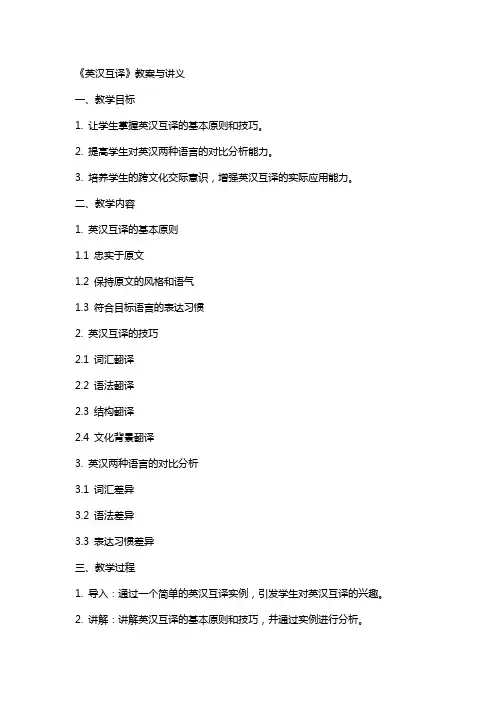
《英汉互译》教案与讲义一、教学目标1. 让学生掌握英汉互译的基本原则和技巧。
2. 提高学生对英汉两种语言的对比分析能力。
3. 培养学生的跨文化交际意识,增强英汉互译的实际应用能力。
二、教学内容1. 英汉互译的基本原则1.1 忠实于原文1.2 保持原文的风格和语气1.3 符合目标语言的表达习惯2. 英汉互译的技巧2.1 词汇翻译2.2 语法翻译2.3 结构翻译2.4 文化背景翻译3. 英汉两种语言的对比分析3.1 词汇差异3.2 语法差异3.3 表达习惯差异三、教学过程1. 导入:通过一个简单的英汉互译实例,引发学生对英汉互译的兴趣。
2. 讲解:讲解英汉互译的基本原则和技巧,并通过实例进行分析。
3. 对比分析:分析英汉两种语言的差异,并讲解如何在翻译过程中进行调整。
4. 练习:布置适量的英汉互译练习题,让学生进行实践操作。
四、教学方法1. 讲授法:讲解英汉互译的基本原则、技巧和语言差异。
2. 案例分析法:通过实例分析,让学生理解和掌握英汉互译的方法。
3. 练习法:让学生通过实际操作,提高英汉互译的能力。
五、教学评价1. 课堂参与度:观察学生在课堂上的积极参与情况和提问回答。
2. 练习完成情况:检查学生完成的英汉互译练习质量和数量。
3. 课后反馈:收集学生的课后反馈,了解他们对英汉互译的认识和困惑。
六、教学资源1. 教材:《英汉互译教程》2. 辅助材料:英汉互译案例集、多媒体课件3. 网络资源:相关英汉互译的在线资料和论坛七、教学环境1. 教室:宽敞、安静,有利于学生集中注意力2. 设备:投影仪、计算机、音响等教学设备八、教学进度安排1. 第一课时:介绍英汉互译的基本原则和技巧2. 第二课时:分析英汉两种语言的差异3. 第三课时:讲解英汉互译的实践操作4. 第四课时:布置练习题,进行课堂练习九、课后作业1. 复习本节课的内容,整理笔记2. 完成布置的英汉互译练习题3. 收集英汉互译相关的资料,进行自主学习十、教学反思2. 对学生的反馈进行整理,针对存在的问题进行调整教学策略3. 不断更新教学资源,提高自身教学水平,以更好地为学生服务重点和难点解析一、教学目标难点解析:跨文化交际意识的培养和实际应用能力的提升。
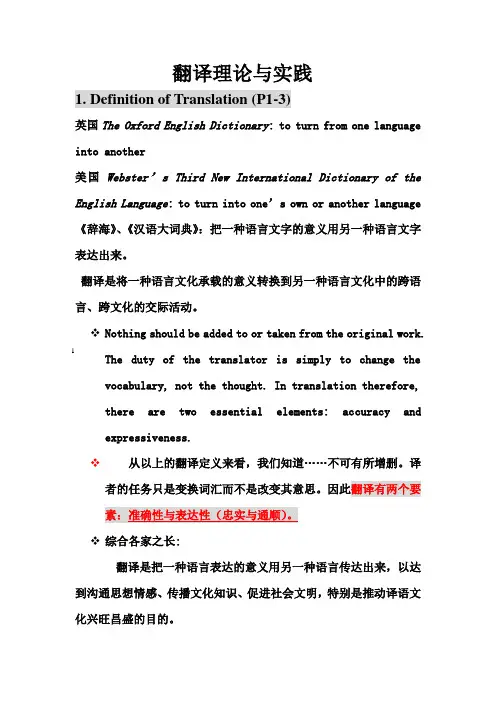
1 翻译理论与实践1. Definition of Translation (P1-3)英国The Oxford English Dictionary: to turn from one language into another美国Webster’s Third New International Dictionary of the English Language: to turn into one’s own or another language 《辞海》、《汉语大词典》:把一种语言文字的意义用另一种语言文字表达出来。
翻译是将一种语言文化承载的意义转换到另一种语言文化中的跨语言、跨文化的交际活动。
❖Nothing should be added to or taken from the original work.The duty of the translator is simply to change thevocabulary, not the thought. In translation therefore,there are two essential elements: accuracy and expressiveness.❖从以上的翻译定义来看,我们知道……不可有所增删。
译者的任务只是变换词汇而不是改变其意思。
因此翻译有两个要❖综合各家之长:翻译是把一种语言表达的意义用另一种语言传达出来,以达到沟通思想情感、传播文化知识、促进社会文明,特别是推动译语文化兴旺昌盛的目的。
2 Three key words from the definitions❖ 1. Textual (What we usually translate are texts rather thanindependent words or sentences.)Eg. 警幻道:“此茶出在放春山遣香洞,又以仙花灵叶上所带之宿露而烹,此茶名曰‘千红一窟’。

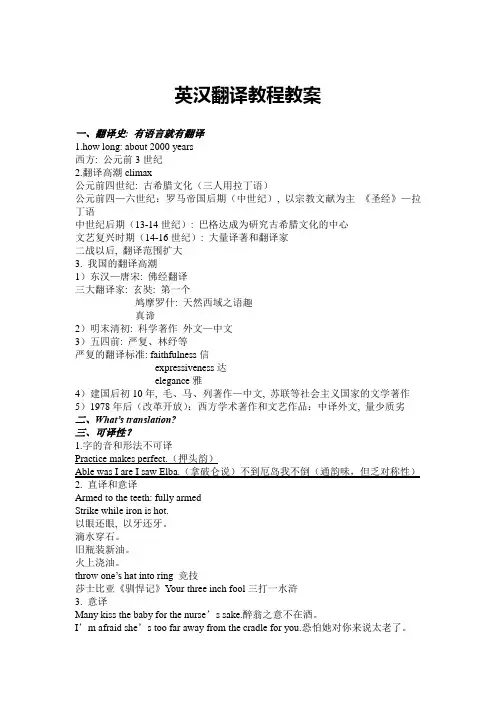
英汉翻译教程教案一、翻译史: 有语言就有翻译1.how long: about 2000 years西方: 公元前3世纪2.翻译高潮climax公元前四世纪: 古希腊文化(三人用拉丁语)公元前四—六世纪:罗马帝国后期(中世纪), 以宗教文献为主《圣经》—拉丁语中世纪后期(13-14世纪): 巴格达成为研究古希腊文化的中心文艺复兴时期(14-16世纪): 大量译著和翻译家二战以后, 翻译范围扩大3. 我国的翻译高潮1)东汉—唐宋: 佛经翻译三大翻译家: 玄奘: 第一个鸠摩罗什: 天然西域之语趣真谛2)明末清初: 科学著作外文—中文3)五四前: 严复、林纾等严复的翻译标准: faithfulness信expressiveness达elegance雅4)建国后初10年, 毛、马、列著作—中文, 苏联等社会主义国家的文学著作5)1978年后(改革开放):西方学术著作和文艺作品:中译外文, 量少质劣二、What’s translation?三、可译性?1.字的音和形法不可译Practice makes perfect.(押头韵)Able was I are I saw Elba.(拿破仑说)不到厄岛我不倒(通韵味,但乏对称性)Armed to the teeth: fully armedStrike while iron is hot.以眼还眼, 以牙还牙。
滴水穿石。
旧瓶装新油。
火上浇油。
throw one’s hat into ring 竞技莎士比亚《驯悍记》Your three inch fool三打一水浒3. 意译Many kiss the baby for the nurse’s sake.醉翁之意不在酒。
I’m afraid she’s too far away from the cradle for you.恐怕她对你来说太老了。
as sweet as a nut甜得像蜜一样He who wants to eat nut must first crack it.Until …… ambition…… 不到黄河不死心。
《英汉互译》教案与讲义教案章节一:英汉互译概述教学目标:1. 了解英汉互译的基本概念和原则。
2. 掌握英汉互译的基本技巧和方法。
3. 能够进行简单的英汉互译实践。
教学内容:1. 英汉互译的概念和定义。
2. 英汉互译的原则和标准。
3. 英汉互译的基本技巧和方法。
4. 英汉互译的实践案例分析。
教学活动:1. 引入英汉互译的概念和定义。
2. 讲解英汉互译的原则和标准。
3. 介绍英汉互译的基本技巧和方法。
4. 提供实践案例,让学生进行翻译练习。
教学评价:1. 学生能够回答英汉互译的概念和定义。
2. 学生能够理解英汉互译的原则和标准。
3. 学生能够掌握英汉互译的基本技巧和方法。
4. 学生能够进行简单的英汉互译实践。
教案章节二:词汇与翻译1. 了解词汇在英汉互译中的重要性。
2. 掌握英汉词汇的差异和转换方法。
3. 能够准确翻译词汇和短语。
教学内容:1. 词汇在英汉互译中的作用和重要性。
2. 英汉词汇的差异和转换方法。
3. 常见词汇和短语的翻译实例。
教学活动:1. 引入词汇在英汉互译中的作用和重要性。
2. 讲解英汉词汇的差异和转换方法。
3. 提供常见词汇和短语的翻译实例。
4. 让学生进行词汇翻译练习。
教学评价:1. 学生能够理解词汇在英汉互译中的重要性。
2. 学生能够掌握英汉词汇的差异和转换方法。
3. 学生能够准确翻译常见词汇和短语。
教案章节三:语法与翻译教学目标:1. 了解语法在英汉互译中的重要性。
2. 掌握英汉语法的差异和转换方法。
3. 能够正确翻译句子和段落。
1. 语法在英汉互译中的作用和重要性。
2. 英汉语法的差异和转换方法。
3. 常见语法错误的分析和纠正。
教学活动:1. 引入语法在英汉互译中的作用和重要性。
2. 讲解英汉语法的差异和转换方法。
3. 提供常见语法错误的分析和纠正。
4. 让学生进行句子和段落的翻译练习。
教学评价:1. 学生能够理解语法在英汉互译中的重要性。
2. 学生能够掌握英汉语法的差异和转换方法。